
Eine Übersicht über die Keywords zum Verkehr. Hier können Sie leicht nach Schlüsselwörtern und Definitionen suchen, die Sie noch nicht kennen.
More subjects
The Audi Coupé was a liftback coupé version of the Audi 80, first shown in 1980. The bodywork was shared with the Audi Quattro. The second generation Coupé arrived in late 1988 and was based on the B3 Audi 80, albeit with a different suspension. The Coupé remained in production until the end of 1996 and spawned the Audi S2 series of sports versions. A convertible model arrived in 1991, called simply the Cabriolet, and remained in production until 2000. The Audi Coupé (B2, Typ 81/85) was a two-door coupé produced and sold by Audi from 1980 to 1988. It was offered as a less expensive version of its turbocharged, permanent four-wheel drive Audi Quattro without turbocharger(s) or four wheel drive. Later, quattro was added as an option (Typ 85). Typ 81 was the internal model code for front-wheel drive Audi Coupés. (Source: Wikipedia.org, CC BY-SA)
 © Wikimedia.org/Tomtomtom, CC BY-SA
© Wikimedia.org/Tomtomtom, CC BY-SA
The Audi Q3 is a subcompact luxury crossover SUV made by Audi. The Q3 has a transverse-mounted front engine, and entered production in 2011. Designed by Julian Hoenig in 2006, it was a concept vehicle with Liquid Silver body colour, 20-inch wheels, fabric folding roof, electrically controlled hood, 4-cylinder 2.0 TDI engine rated at 204 PS (150 kW; 201 hp) and 400 N⋅m (295.02 lbf⋅ft), diesel particulate filter and Bluetec emission control system, quattro permanent four-wheel drive system with Haldex clutch, Audi S tronic dual-clutch gearbox, MacPherson strut front axle and a four-link rear axle, Audi drive select system with 3 modes (dynamic, sport, efficiency), MMI control panel with touch pad and dual-view technology, sound system with the prominent extending tweeters. The vehicle was unveiled at the Shanghai Motor Show in April, 2007. (Source: Wikipedia.org, CC BY-SA)
The Audi Q5 is a series of compact luxury crossover SUVs produced by the German luxury car manufacturer Audi from 2008. The original first-generation (Typ 8R) model was the third member of the B8 family to be released after the Audi A5 and fourth-generation A4, all being based on the Audi MLB platform. The second generation Q5 (Typ 80A) debuted in 2016 and shares the Audi MLB Evo platform with the corresponding B9 versions of the A4 and A5. A concept vehicle for the then upcoming Q5, this was a 2-door convertible with a 3.0 TDI engine rated at 240 PS (177 kW; 237 hp) and 500 N⋅m (369 lbf⋅ft) torque, quattro permanent four wheel drive, 8-speed automatic transmission, Copper Sunset body, LED headlights, 21-inch wheels with 265/35R21 tyres, seats with White Stone leather upholstery, MMI, 505W Bang & Olufsen sound system and internet radio, CDC (continuous damping control) shock absorbers, electric ride height adjustment (40 mm), 380/356 mm front/rear ceramic brake discs with 6-piston monobloc aluminium front, and floating rear callipers, Audi Drive Select. The vehicle was unveiled at the 2007 Los Angeles Auto Show. (Source: Wikipedia.org, CC BY-SA)
The Audi Q7 is a crossover SUV made by the German manufacturer Audi, unveiled in September 2005 at the Frankfurt Motor Show. Production of this seven-seater SUV began in the autumn of 2005 at the Volkswagen Bratislava Plant in Bratislava, Slovakia. It is the largest model Audi sell. It has been described by Car magazine, What Car?, and the RAC as 'huge'. The Q7 was one of the vehicles involved in the Volkswagen emissions scandal, with the company ordered to buy back some of the affected cars manufactured between 2009 and 2012. It was the first SUV sold by Audi and went on sale in 2006. Later, Audi's second SUV, the Q5, was unveiled as a 2009 model. Audi has since unveiled a third SUV model, the Q3, which went on sale in the third quarter of 2011, and a fourth SUV model, the Q2, which went on sale in November 2016. The Q7 shares a Volkswagen Group MLB platform and chassis with the Bentley Bentayga, Lamborghini Urus, Porsche Cayenne and the Volkswagen Touareg. (Source: Wikipedia.org, CC BY-SA)
The Audi Quattro is a road and rally car, produced by the German automobile manufacturer Audi, part of the Volkswagen Group. It was first shown at the 1980 Geneva Motor Show on 3 March. Production continued through 1991. The word quattro is derived from the Italian word for 'four' to represent the fact that the vehicle delivers power to all four wheels. The name has also been used by Audi to refer to the quattro four-wheel-drive system, or any four-wheel-drive version of an Audi model. The original Quattro model is also commonly referred to as the Ur-Quattro - the 'Ur-' (German for 'primordial', 'original', or 'first of its kind') is an augmentative prefix. The idea of such a car came from the Audi engineer Jörg Bensinger. (Source: Wikipedia.org, CC BY-SA)
The Audi R8 is a mid-engine, 2-seater sports car, which uses Audi's trademark quattro permanent all-wheel drive system. It was introduced by the German car manufacturer Audi AG in 2006. The car is exclusively designed, developed, and manufactured by Audi AG's private subsidiary company manufacturing high performance automotive parts, Audi Sport GmbH (formerly quattro GmbH), and is based on the Lamborghini Gallardo and presently the Huracán platform. The fundamental construction of the R8 is based on the Audi Space Frame, and uses an aluminium monocoque which is built using space frame principles. The car is built by Audi Sport GmbH in a newly renovated factory at Audi's 'aluminium site' at Neckarsulm in Germany. It is also the first production car with full-LED headlamps. (Source: Wikipedia.org, CC BY-SA)
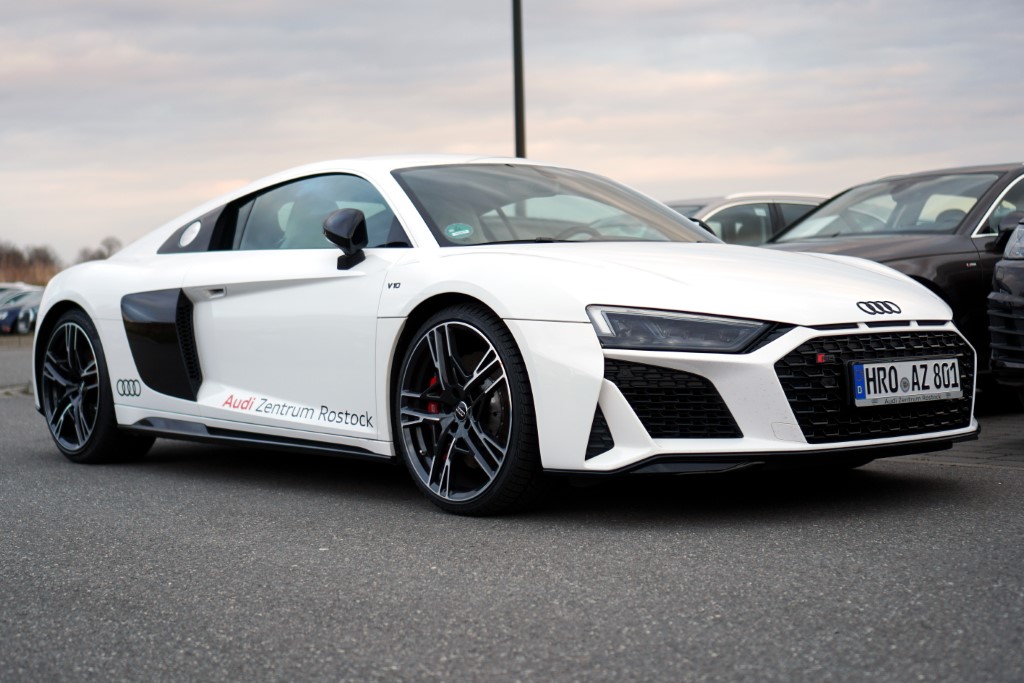 © Wikimedia.org/Sestmedia, CC BY-SA
© Wikimedia.org/Sestmedia, CC BY-SA
The Audi RS 4 is the high-performance variant of the Audi A4 range produced by Audi Sport GmbH for AUDI AG, a division of the Volkswagen Group. It sits above the Audi S4 as the fastest, most sports-focused car based on the A4's 'B' automobile platform. The RS 4 was reintroduced in 2012, based on the A4 Avant instead of the sedan as did the original model. The original B5 version was produced only as an Avant, Audi's name for an estate car/station wagon. The second version, the B7, was released initially as a four-door five-seat saloon/sedan, with the Avant following a short while later. A two-door four-seat Cabriolet version was subsequently added. The 'RS' initials are taken from the German RennSport—literally translated as 'racing sport', and is the Audi marque's highest trim level, positioned above the 'S' model specification of Audi's regular model line-up. Like other Audi 'RS' cars, the RS 4 pioneers some of Audi's latest advanced technology. It is only available with Audi's Torsen-based 'trademark' quattro permanent four-wheel drive system. (Source: Wikipedia.org, CC BY-SA)
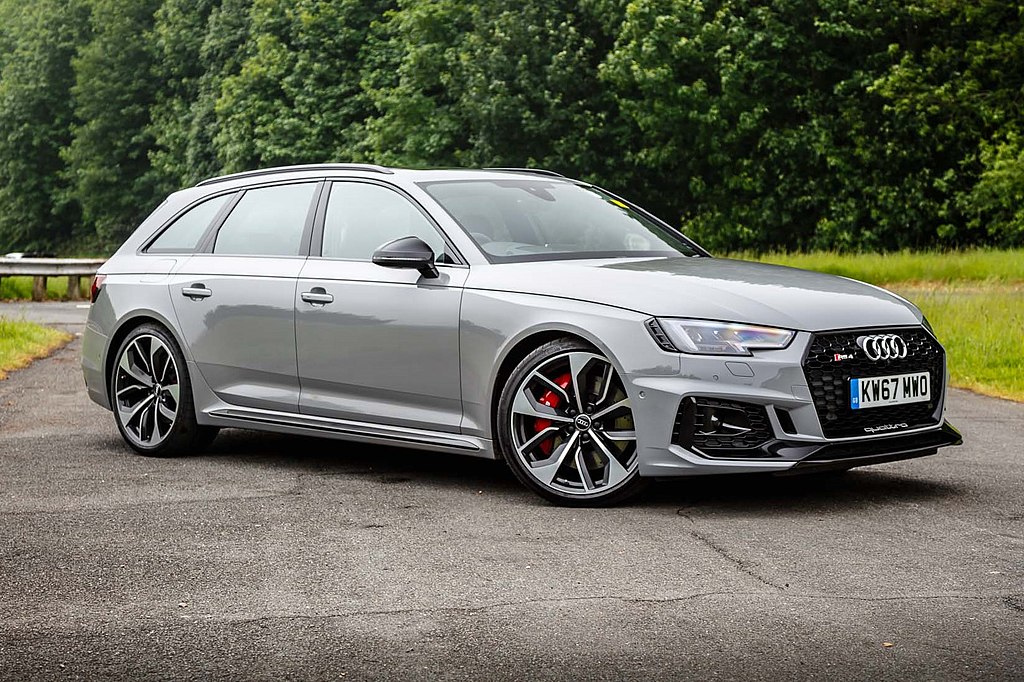 © Wikimedia.org/Motor Verso, CC BY
© Wikimedia.org/Motor Verso, CC BY
The Audi RS 6 is a high-performance variant of the Audi A6 range, produced by the high-performance subsidiary company Audi Sport GmbH, for its parent company Audi AG, a subsidiary of the Volkswagen Group, from 2002 onwards. The first and second versions of the RS 6 were offered in both Avant and saloon forms. The third and fourth generations are only offered as an Avant. The 'RS' initials are taken from the German: RennSport – literally translated as 'racing sport', and is Audi's ultimate 'top-tier' high-performance trim level, positioned a noticeable step above the 'S' model specification level of Audi's regular model range line-up. Like all Audi 'RS' models, the RS 6 pioneers some of Audi's newest and most advanced engineering and technology, and so could be described as a halo vehicle, with the latest RS 6 Performance having the equal most powerful internal combustion engine out of all Audi models, with the same horsepower and torque as the physically larger Audi S8 Plus. Unlike the A6 and S6, however, the RS 6's engines in the C5 and C6 iterations have not been shared with any other vehicle in Audi's lineup. However, for the C7 generation, the Audi RS 6 has the same 4.0L bi-turbo V8 engine as the Audi RS 7, with both being positioned at the top of the Audi S and RS range, and detuned variants of the same engines are found in the Audi S8, Audi A8, and Audi S6. (Source: Wikipedia.org, CC BY-SA)
The Audi S4 is the high performance variant of Audi's compact executive car A4. The original Audi S4, built from 1991 until 1994, was a performance-oriented version of Audi's 100 saloon/sedan. All subsequent S4s since 1997 have been based on the Audi A4; and as the A4 has evolved from one generation to the next, so has the S4. A more powerful internal combustion engine, larger upgraded brakes, firmer suspension, larger wheels, and distinctive sheetmetal, styling clues and badging have always been amongst the many upgrades the S4 receives over its mainstream 100 and A4 siblings. In markets where the even higher-performance Audi RS 4 is not offered, the S4 is the top-of-the-line trim of the A4 family. (Source: Wikipedia.org, CC BY-SA)
The Audi S5 is one of two high-performance variants of Audi's A5. It is also the coupé, cabriolet, and five-door fastback sedan versions of the fourth-generation (B8) Audi S4 saloon and estate models. Like all Audi 'S' cars, they are only available with Audi's quattro four-wheel drive (4WD) system, here in S5 using a Torsen-based centre diff system. Most versions of the S5 are manufactured at Audi's plant in Ingolstadt, Germany; they are available as a coupé, cabriolet, and five-door sportback, which was previously not available in North America until the 2018 model year, which was released in the United States in mid 2017. The cabriolets are built at Audi's factory in Neckarsulm, Germany. (Source: Wikipedia.org, CC BY-SA)
The Audi S6 is the performance variant of the Audi A6, an executive car produced by German automaker Audi. It went on sale in 1994, shortly after the 'A6' designation was introduced, replacing the '100' nameplate. The original S6 was largely the same car as the outgoing, original Audi S4 (C4) (Ur-S4), with the only visible differences being new body-cladding and badging. In certain markets where the even-higher performance RS6 (which is also based on the A6) is not sold, the S6 is the most powerful A6 trim there. The S6, like all Audi 'S' models, is fitted as standard with Audi's trademark quattro four-wheel drive (4WD) system, the S6 using the Torsen-based permanent 4WD. (Source: Wikipedia.org, CC BY-SA)
The Austin Allegro is a small family car that was manufactured by the Austin-Morris division of British Leyland from 1973 until 1982. The same vehicle was built in Italy by Innocenti between 1974 and 1975 and sold as the Innocenti Regent. The Allegro was designed as a replacement for the Austin 1100 and 1300 models. In total, 642,350 Austin Allegros were produced during its ten-year production life, most of which were sold on the home market, less than a third of 2.1 million 1100s and 1300s sold in the previous 11 years. It was built and sold by British Leyland alongside the hatchback Austin Maxi (launched in 1969) and the 1971 rear-wheel-drive Morris Marina. All three were eventually replaced by the Austin Maestro in 1983. (Source: Wikipedia.org, CC BY-SA)
The Austin-Healey Sprite is a small open sports car produced in the United Kingdom from 1958 until 1971. The Sprite was announced to the press in Monte Carlo by the British Motor Corporation on 20 May 1958, two days after that year's Monaco Grand Prix. It was intended to be a low-cost model that 'a chap could keep in his bike shed', yet be the successor to the sporting versions of the pre-war Austin Seven. The Sprite was designed by the Donald Healey Motor Company, with production being undertaken at the MG factory at Abingdon. It first went on sale at a price of £669, using a tuned version of the Austin A-Series engine and as many other components from existing cars as possible to keep costs down. When the Mk. II Sprite was introduced in 1961 it was joined by a badge-engineered MG version, the Midget, reviving a model name used by MG from the late 1920s through to the mid 1950s. Enthusiasts often refer to these later Sprites and Midgets collectively as 'Spridgets.' The MG-badged version of the car continued in production for several years after the Austin-Healey brand ceased to exist. (Source: Wikipedia.org, CC BY-SA)
The Austin Maestro is a five-door hatchback small family car (and two-door van derivative) that was produced from 1982 to 1987 by British Leyland, and from 1988 until 1994 by Rover Group, as a replacement for the Morris Marina and Austin Allegro. The car was produced at Morris' former Oxford plant, also known as Cowley, with 605,000 units sold. Today, the redeveloped factory builds the BMW Mini. An MG-branded performance version was sold as the MG Maestro from 1983 until 1991. Although later models were sometimes referred to as the Rover Maestro, the model never wore the Rover badge. The Austin Montego saloon was a variant of the Maestro. (Source: Wikipedia.org, CC BY-SA)
The Austin Metro is a supermini car, later a city car that was produced by British Leyland (BL) and, later, the Rover Group from 1980 to 1998. It was launched in 1980 as the Austin mini Metro. It was intended to complement and eventually replace the Mini, and was developed under the codename LC8. The Metro was named by What Car? magazine as 'Car of The Year' in 1983 as an MG, and again as the Rover Metro in 1991.[citation needed] During its 18-year lifespan, the Metro wore many names: Austin Metro, MG Metro and Rover Metro. It was rebadged as the Rover 100 series in December 1994. There were also van versions known as the Morris Metro and later, Metrovan. At the time of its launch, the Metro was sold under the Austin brand. From 1982, MG versions became available. During 1987, the car lost the Austin name, and was sold simply as the Metro. From 1990 until its withdrawal in 1998, the Metro was sold only as a Rover. (Source: Wikipedia.org, CC BY-SA)
The Austin Montego is a British family car that was produced by British Leyland from 1984 until 1988, and then by Rover Group from 1988 until 1995. The Montego was the replacement for both the rear-wheel drive Morris Ital and the front-wheel drive Austin Ambassador ranges to give British Leyland an all-new competitor for the Ford Sierra and Vauxhall Cavalier. On its launch, it was sold as both an Austin and an MG. It was the last car to be launched under the Austin marque, and from 1988 it was sold without a marque, following the phasing out of the Austin name.[citation needed] (Source: Wikipedia.org, CC BY-SA)
The Autobianchi A111 is a 4-door saloon family car produced from 1969 to 1972 by Italian car manufacturer Autobianchi, a subsidiary of the Fiat group. Despite rather modest dimensions, at roughly 4 metres long, it was the largest Autobianchi ever made, as the brand specialized in small cars. A modern front-wheel drive construction like the Fiat 128 launched concurrently, it was based on the revolutionary Autobianchi Primula, Fiat's first 'experiment' with the transverse engine front-wheel-drive setup. (Source: Wikipedia.org, CC BY-SA)
The Autobianchi A112 is a supermini produced by the Italian automaker Autobianchi. It was developed using a shrunken version of the contemporary Fiat 128's platform. The mechanicals of the A112 subsequently underpinned the Fiat 127. It was introduced in November 1969, as a replacement for the Bianchina and Primula, and was built until 1986, when it made way for the more modern Autobianchi Y10 (branded in most export markets as the Lancia Y10). Over 1.2 million A112s were produced in Autobianchi's Milan factory. (Source: Wikipedia.org, CC BY-SA)
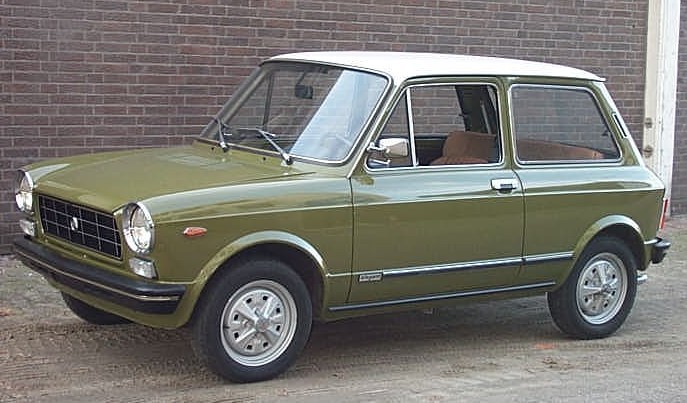 © Wikimedia.org/Garage de l'Est, CC BY-SA
© Wikimedia.org/Garage de l'Est, CC BY-SA
The Autobianchi Y10 is a city car and economy car manufactured from 1985 to 1995 and marketed under the Lancia brand in most export markets (as Lancia Y10). The car was manufactured at Fiat's Autobianchi plant in Desio, Milan until 1992 and after that in Arese, near Alfa Romeo's plants. In addition to a relatively high level of trim for its market segment, the Y10 featured a new rear rigid axle suspension design (called Omega axle), subsequently shared with the facelifted Fiat Panda. The Y10 had a drag coefficient of just 0.31. Production totaled approximately 850,000 in the first seven years. Lancia remained in the segment with the similarly marketed Ypsilon. Sales in the United Kingdom were not strong, and it was withdrawn in late 1991. This was more than two years before Lancia withdrew entirely from Britain and all other RHD markets. (Source: Wikipedia.org, CC BY-SA)
The Studebaker Avanti is a personal luxury coupe manufactured and marketed by Studebaker Corporation between June 1962 and December 1963. A halo car for the maker, it was marketed as 'America's only four-passenger high-performance personal car.'Described as 'one of the more significant milestones of the postwar industry',: p257 the Raymond Loewy-designed car offered safety features and high-speed performance. Called “the fastest production car in the world” upon its introduction, a modified Avanti reached over 170 mph (270 km/h) with its supercharged 289-cubic-inch (4,740 cm3) R3 engine at the Bonneville Salt Flats. In all, it broke 29 world speed records at the Bonneville Salt Flats. Following Studebaker's discontinuation of the model, a succession of five ventures manufactured and marketed derivatives of the Avanti model through 2006. These ventures licensed intellectual property and, in some cases procured parts, through arrangements with the successors to the Studebaker assets. (Source: Wikipedia.org, CC BY-SA)
The BMC ADO16 is a range of small family cars built by the British Motor Corporation (BMC) and, later, British Leyland. Launched in 1962, it was Britain's best-selling car from 1963 to 1966 and from 1968 to 1971. The ADO16 was marketed under various make and model names; however, the Austin 1100 and Morris 1100 were the most prolific of all the ADO16 variants. The car's ubiquity at the height of its popularity led to it simply being known as the 1100 (eleven-hundred) in its home market. In production for 12 years, the ADO16 range sold 2.1 million units between 1962 and 1974, more than half of those being sold on the UK home market. British Leyland phased out the 1100/1300 between 1971 and 1974 in favour of the Morris Marina and the Austin Allegro. (Source: Wikipedia.org, CC BY-SA)
BMC ADO17 is the model code used by the British Motor Corporation (BMC) for a range of large family cars manufactured from September 1964 to 1975. The car was initially sold under the Austin marque as the Austin 1800, then by Morris as the Morris 1800, by Wolseley as the Wolseley 18/85, and later the Austin 2200, Morris 2200 and Wolseley Six. The 1800 was voted European Car of the Year for 1965. The Austin 1800 was developed at BMC as a larger follow-up to the successful Mini and Austin 1100 under the ADO17 codename, ADO being an abbreviation for Amalgamated Drawing Office. Additional badge-engineered Morris 1800 and Wolseley 18/85 variants were launched in 1966 and 1967 respectively, catering for the BMC dealerships selling those marques. The 18/85 name had previously been used on the Wolseley 18/85 of 1938 to 1948. (Source: Wikipedia.org, CC BY-SA)
The BMW 3 Series is a line of compact executive cars manufactured by the German automaker BMW since May 1975. It is the successor to the 02 Series and has been produced in seven generations. The first generation of the 3 Series was only available as a 2-door saloon; however, the model range has since expanded to include a 4-door saloon, 2-door convertible, 2-door coupé, 5-door estate, 5-door liftback ('Gran Turismo') and 3-door hatchback body styles. Since 2013, the coupé and convertible models have been marketed as the 4 Series; therefore, the 3 Series range no longer includes these body styles. The 3 Series is BMW's best-selling model, accounting for around 30% of the BMW brand's annual total sales (excluding motorbikes), and has won numerous awards throughout its history. The M version of the 3 series, M3, debuted with the E30 M3 in 1986. (Source: Wikipedia.org, CC BY-SA)
The BMW 3200 CS was a sports touring car manufactured by BMW between January 1962 and September 1965. It was designed by Bertone and was introduced at the 1961 Frankfurt Motor Show. More than five hundred were built. The 3200 CS was the final variation on BMW's early postwar luxury platform that began with the 501 introduced in 1951. The styling of the 3200 CS influenced the 2000 CS coupe version of the New Class and the later New Six coupes. It was the first BMW to feature the Hofmeister kink (which would become one of the company's trademark design elements). (Source: Wikipedia.org, CC BY-SA)
The BMW 326 is a medium-sized sedan produced by BMW between 1936 and 1941, and again briefly, under Soviet control, after 1945. The 326 was BMW's first four-door sedan. It had an innovative design and sold well despite its relatively high price. It also had an unusually involved afterlife. Designed by Fritz Fiedler, the 326 featured a box-section frame that could readily be adapted for derivative models.[citation needed] Also innovative were the torsion bar rear suspension, inspired by the dead axle suspension of the Citroën Traction Avant, and the hydraulic braking system, the first to be used on a BMW car. Styled by Peter Schimanowski, the 326 was offered as a four-door sedan and as a two- or four-door cabriolet. The 326 sedan was the first BMW available with four doors. The BMW 320, BMW 321, BMW 327, and BMW 335 were based on the 326. The streamlined form of the body contrasted with previous relatively upright BMWs: drag was presumably reduced further by including a fixed cover over the spare wheel at the back.[citation needed] (Source: Wikipedia.org, CC BY-SA)
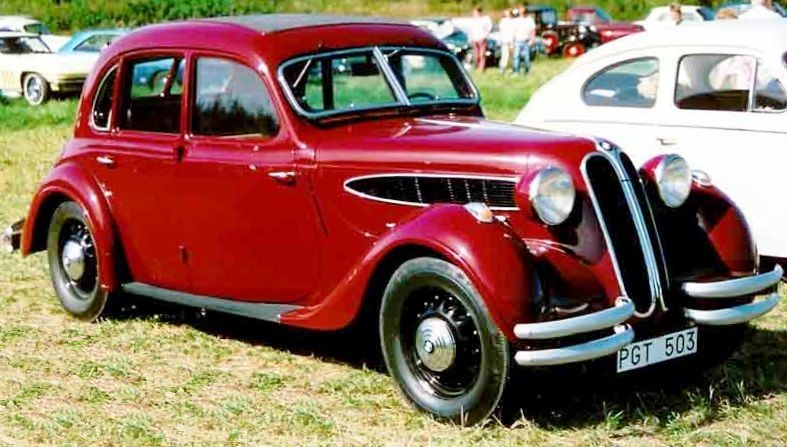 © Wikimedia.org/Lars-Göran Lindgren, CC BY-SA
© Wikimedia.org/Lars-Göran Lindgren, CC BY-SA
The BMW 327 is a medium-sized touring coupé produced by the Bavarian firm between 1937 and 1941, and again produced after 1945, temporary under the Soviet control. It sat on a shortened version of the BMW 326 chassis. The first 327, launched in 1937, was a cabriolet. In 1938, this was joined by a fixed head coupé version. The car was shorter and lower than its sedan counterpart, but shared the famous BMW grill and a streamlined form representative of the more progressive designs of the 1930s. (Source: Wikipedia.org, CC BY-SA)
The BMW 328 was a sports car offered by BMW from 1936 to 1940, with the body design credited to Peter Szymanowski, who became BMW chief of design after World War II (although technically the car was designed by Fritz Fiedler). After the Second World War, the manufacturing plant in Eisenach where the 328 had been built found itself in the Soviet occupation zone, and automobile manufacturing in Eisenach would follow a state-directed path until German Reunification in 1989. (Source: Wikipedia.org, CC BY-SA)
The BMW 335 is a six-cylinder sports sedan produced by the Bavarian firm BMW between 1939 and 1941. Commercial success for the BMW 326, introduced in 1936, encouraged a move upmarket. This would involve BMW in challenging the dominance then enjoyed by Mercedes-Benz over a lucrative sector, with their 320 and 340 models. BMW were producing, in their Eisenach plant, the model that would form the basis for the larger car. The 326 had already spawned successful sporting derivatives. The 335 was also to be based on the 326, but with the wheelbase and chassis extended to accommodate a 3485 cc M335 six-cylinder in-line engine. Despite clearly reflecting the approach taken with existing BMW units, this was an entirely new design. Claimed maximum power output of 90 bhp (67 kW) was lower than the values advertised for comparably sized and powered Jaguars of the period, it achieved full power at only 3500 rpm. With 90 bhp (67 kW), the car had top speed of 145 km/h (90 mph). (Source: Wikipedia.org, CC BY-SA)
The BMW 4 Series is a range of compact executive cars manufactured by BMW since 2013. The 4 Series was created when BMW spun off the 2-door models (coupé and convertible) of the 3 Series into a separate series. The 4 Series is currently in its second generation. The original 4 Series concept car was unveiled in January 2013 at the North American International Auto Show in Detroit, Michigan. Both generations have been produced in the coupé, convertible and 5-door liftback (marketed as 'Gran Coupé') body styles. The 4 series body style is very similar to that of the all electric BMW i4. The engines available for the first generation were turbocharged inline-3, inline-4 and inline-6 engines fueled by petrol or diesel. For the second generation, a plug-in hybrid powertrain was introduced. As per the equivalent 3 Series generations, the 4 Series' drivetrain layout is rear-wheel drive or all-wheel drive ('xDrive'). The BMW M4 is the high-performance version of the 4 Series. The first generation of the M4 is called the F82/F83 and uses the same turbocharged inline-six petrol engine as the F80/F81 M3. (Source: Wikipedia.org, CC BY-SA)
The BMW 5 Series is an executive car manufactured and marketed by BMW since 1972, succeeding the New Class Sedans, and currently in its seventh generation. The 5 Series was initially available as a sedan, with a wagon/estate body style (marketed as 'Touring') added in 1991 and a 5-door fastback configuration (marketed as 'Gran Turismo') available from 2009 to 2017. Each successive generation carries a distinct internal E- designation. The first generation of 5 Series was powered by naturally aspirated four-cylinder and six-cylinder petrol engines. Following generations have been powered by four-cylinder, six-cylinder, V8 and V10 engines that are either naturally aspirated or turbocharged. Since 1982, diesel engines have been included in the 5 Series range. The 5 Series is BMW's second-best-selling model after the 3 Series. On 29 January 2008, the 5 millionth 5 Series was manufactured, a 530d sedan in Carbon Black Metallic. BMW's three-digit model naming convention began with the first 5 Series, thus the 5 Series was BMW's first model line to use 'Series' in the name. Since the E28, all generations of 5 Series have included an 'M' model, called the BMW M5. (Source: Wikipedia.org, CC BY-SA)
The BMW 503 is a two-door 2+2 gran turismo in both Coupé and Cabriolet form manufactured by German automaker BMW from 1956 until 1959. The company developed the 503 alongside the 507 roadster in an attempt to sell a significant number of luxury cars in the United States. The 503 and 507 cost about twice their projected price and did not recover their costs. During production from May 1956 to March 1959, 413 units of the 503 were built, 139 of which were Cabriolets. Even though it was a prestige model it resulted in heavy losses for BMW. (Source: Wikipedia.org, CC BY-SA)
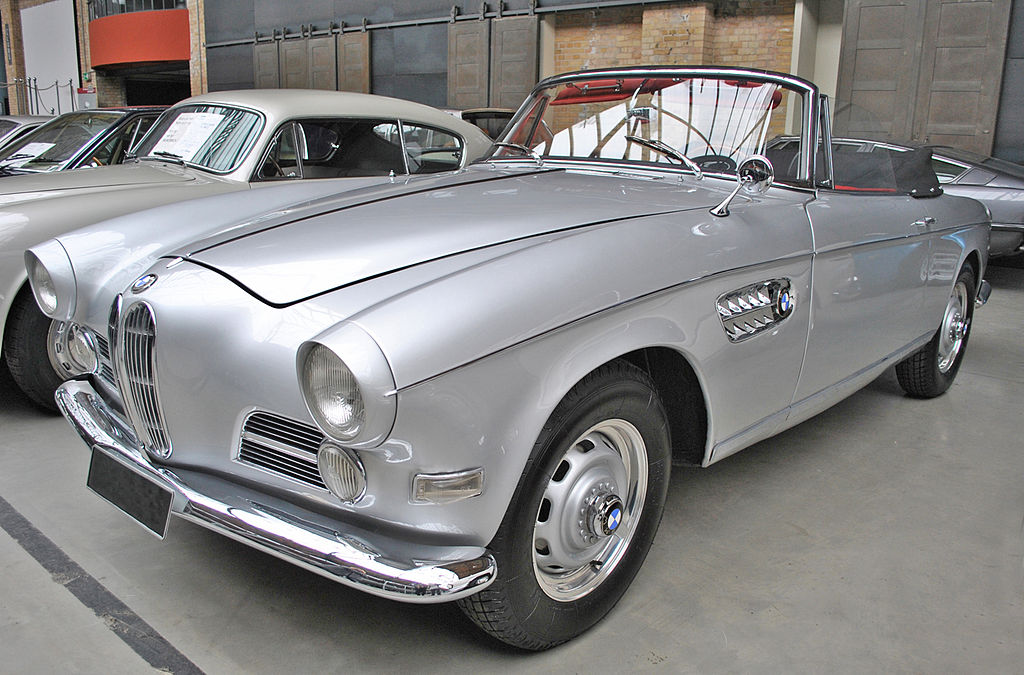 © Wikimedia.org/Olli1800, CC BY-SA
© Wikimedia.org/Olli1800, CC BY-SA
The BMW 507 is a grand touring convertible that was produced by German automobile manufacturer BMW from 1956 until 1959. Initially intended to be exported to the United States at a rate of thousands per year, it ended up being too expensive, resulting in a total production figure of 252 cars and heavy financial losses for BMW. The BMW 507 was conceived by U.S. automobile importer Max Hoffman who, in 1954, persuaded the BMW management to produce a roadster version of the BMW 501 and BMW 502 saloons to fill the gap between the expensive Mercedes-Benz 300SL and the cheap and underpowered Triumph and MG sports cars. BMW engineer Fritz Fiedler was assigned to design the rolling chassis, using existing components wherever possible. Early body designs by Ernst Loof were rejected by Hoffman, who found them to be unappealing. In November 1954, at Hoffman's insistence, BMW contracted designer Albrecht von Goertz to design the BMW 503 and the 507. (Source: Wikipedia.org, CC BY-SA)
The BMW 6 Series is a range of grand tourers produced by BMW since 1976. It is the successor to the E9 Coupé and is currently in its fourth generation. The first generation BMW E24 6 Series was available solely as a two-door coupé and produced from 1976 to 1989, when it was supplanted by the larger BMW 8 Series (E31). When the 6 Series nameplate was revived in 2004 for the second generation, the BMW E63/E64 6 Series, the coupé was joined by a convertible body style. The third generation F06/F12/F13 6 Series debuted in 2011 as a coupé and convertible, and added a four-door coupé body style (known as the Gran Coupé) in 2012. When the F06/F12/F13 6 Series ended production, the 'Gran Coupé'/coupé/convertible models have been shifted into the more upmarket BMW 8 Series (G15) nameplate. The fourth generation 6 Series, the G32 6 Series, debuted in mid-2017 and is offered only as a fastback body style to complement the BMW 5 Series (G30) sedan/wagon. (Source: Wikipedia.org, CC BY-SA)
The BMW 7 Series is a full-size luxury sedan manufactured and marketed by the German automaker BMW since 1977. It is the successor to the BMW E3 'New Six' sedan and is now in its seventh generation. The 7 Series is BMW's flagship car and is only available in a sedan bodystyle (including long wheelbase and limousine models). It traditionally introduces technologies and exterior design themes before other models in BMW's lineup. The first generation of the 7 Series was powered by straight-6 petrol engines, and following generations have been powered by inline-4, straight-6, V8 and V12 engines with both natural aspiration and turbocharging. Since 1995, diesel engines have been optional in the 7 Series. Unlike the 3 Series and 5 Series sedans, BMW has offered a nonpureblood M variant, the BMW M760 6.6L V12 (at the time the most powerful BMW ever made, not to be confused with BMW 760 6.6 V12 which does not offer the same performance). The Alpina B7 (G12) serves as one of the high-performance variants of the 7 Series. (Source: Wikipedia.org, CC BY-SA)
The BMW 8 Series is a range of grand tourer coupes and convertibles produced by BMW. The 8 Series was introduced in 1990 under the E31 model code and was only available as a two-door coupé. It is powered by a range of naturally aspirated V8 and V12 petrol engines. The E31 started production just as E24 6 Series production ended, however it is not considered a direct successor. The E31 was discontinued in 1999 due to poor sales. The model range was later reintroduced in 2018 with the second generation, G15 8 Series. It launched in coupé (G15), convertible (G14), and four-door Gran Coupé (G16) body styles, as the successor to the F06/F12/F13 6 Series lineup. The G15 8 Series introduces an inline-six diesel engine, and a high-performance BMW M8 trim later joined the lineup as well as the luxury inspired Alpina B8. (Source: Wikipedia.org, CC BY-SA)
The BMW E9 is a range of coupés produced from 1968 to 1975. Initially released as the 2800 CS model, the E9 was based on the BMW 2000 C / 2000 CS four-cylinder coupés, which were enlarged to fit the BMW M30 six-cylinder engine. The E9 bodywork was built by Karmann. As a racing car, the E9 was very successful in the European Touring Car Championship and the Deutsche Rennsport Meisterschaft, especially the 3.0 CSL homologation model. The E9 range was replaced by the E24 6 Series. (Source: Wikipedia.org, CC BY-SA)
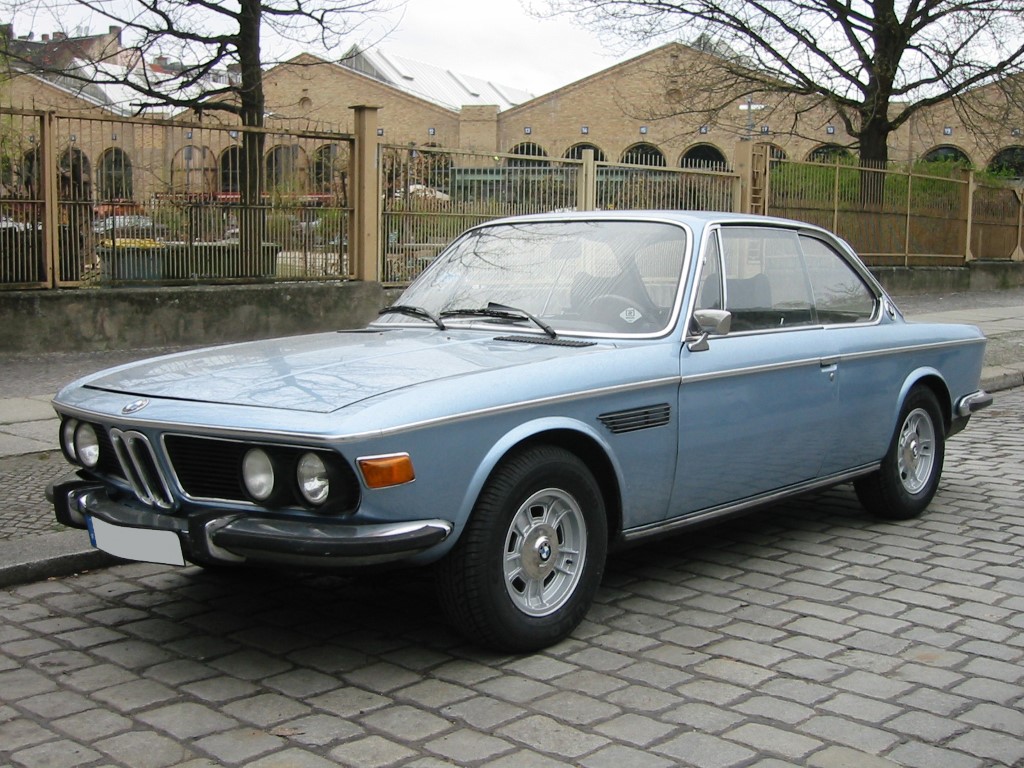 © Wikimedia.org/Olli1800, CC BY-SA
© Wikimedia.org/Olli1800, CC BY-SA
The BMW M1 (model code E26) is a mid-engined sports car produced by German automotive manufacturer BMW from 1978 until 1981. In the late 1970s, Italian automobile manufacturer Lamborghini entered into an agreement with BMW to build a production racing car in sufficient quantity for homologation, but conflicts arose that prompted BMW to produce the car themselves. The resulting car was sold to the public, from 1978 until 1981, as the BMW M1. It is the first mid-engine BMW automobile to be mass-produced; the second is the i8 plug-in hybrid sports car. (Source: Wikipedia.org, CC BY-SA)
The BMW M3 is a high-performance version of the BMW 3 Series, developed by BMW's in-house motorsport division, BMW M GmbH. M3 models have been produced for every generation of 3 Series since the E30 M3 was introduced in 1986. The initial model was available in a coupé body style, with a convertible body style added soon after. M3 saloons were available during the E36 (1994–1999) and E90 (2008–2012) generations. Since 2014, the coupé and convertible models have been rebranded as the 4 Series range, making the high-performance variant the M4, so that generation of 3 Series saw the M3 produced only as a saloon. In 2020, the M3 was produced as an estate (Touring) for the first time, alongside the saloon. (Source: Wikipedia.org, CC BY-SA)
The BMW M5 is a high performance variant of the BMW 5 Series marketed under the BMW M sub-brand. It is considered an iconic vehicle in the sports sedan category. The majority of M5s have been produced in the sedan (saloon) body style, but in some countries the M5 was also available as a wagon (estate) from 1992 to 1995 and from 2006 to 2010. The first M5 model was hand-built in 1985 on the E28 535i chassis with a modified engine from the M1 that made it the fastest production sedan at the time. M5 models have been produced for every generation of the 5 Series since 1985. (Source: Wikipedia.org, CC BY-SA)
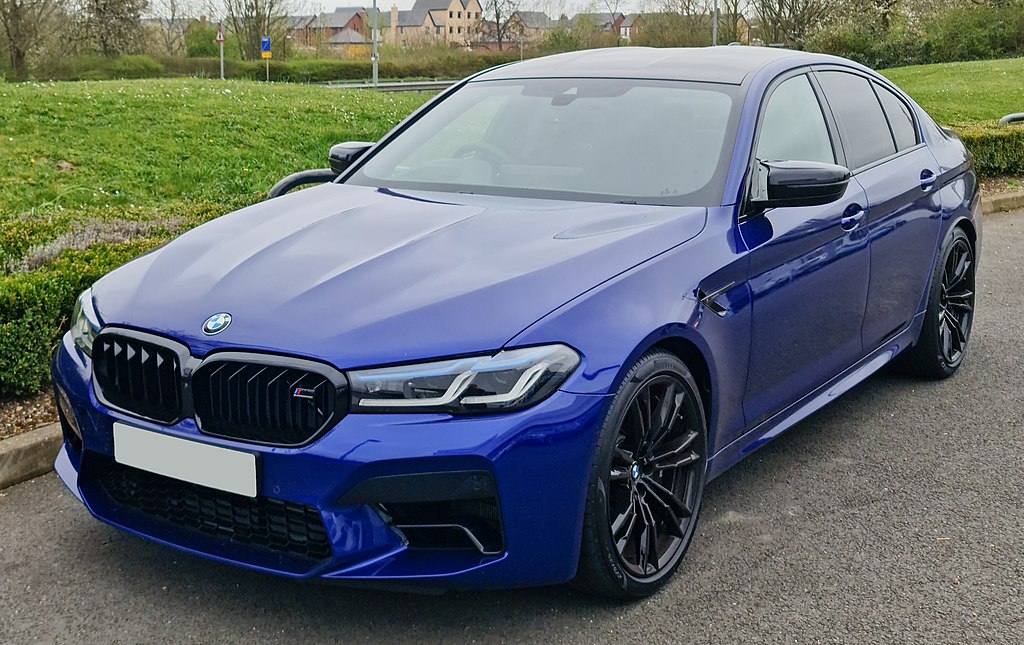 © Wikimedia.org/Liam Walker, CC BY-SA
© Wikimedia.org/Liam Walker, CC BY-SA
The BMW New Class (German: Neue Klasse) was a line of sedans and coupes produced by German automaker BMW between 1962 and 1977. These models ensured BMW's solvency after the company's financial crisis of the 1950s and established the identity of BMW automobiles as sports sedans. The first New Class vehicle was the 1500, a 4-door compact executive car with the new M10 (at the time called M115) OHC 4-cylinder engine. In 1965, the 2000C and 2000CS luxury coupés were added to the range. Replacement of the New Class models began with the larger 2000C and 2000CS coupés, which were replaced by the 6-cylinder E9 2800CS in 1969. In 1972, the 4-door sedans were replaced by the larger E12 5 Series. (Source: Wikipedia.org, CC BY-SA)

Time for recess! Post a comment, ask a question or write a review. Feel free to let us know what you think!
was bedeutet rechts oder links übergabe.für mich ist es eine Strassenteilung re oder li
In Malaysia gibt es gelbe und weiße Linien zum Begrenzen der Fahrbahnen. Was bedeutet eine weiße Linie und eine gelbe Linie im Zusammenhang mit dem Halten/Parken eines Autos. innerhalb einer Ortschaft?
Fehler: "Rechtsübergabe". Okay, dieser Test ist komplett unbrauchbar. Reine Zeitschwendung.
Fehler: Bei einem Richtungswegweiser ist die erwartete Antwort: "Informationen zum Ziel der Rampe.".
Fehler: Ein dreieckiges Schild mit einem Fahrrad ist eine Warnung *vor* Radfahrern. Keine Warnung *für* Radfahrern.
An sich ganz hilfreich, aber bei einem so sensiblen Thema die Texte dermaßen schlecht zu übersetzen, geht gar nicht! Die Antwortmöglichkeiten sind so verwirrend geschrieben, daß ich teilweise nicht wußte, was gemeint war, und dementsprechend Fehler kassiert habe. Ich biete mich hiermit an, die Übersetzungen zu überarbeiten.
Dear future partners! We are European manufacturers and distributors of buoys designed to serve road and highway maintenance, driver training and sports purposes. We kindly recommend our spaces to your attention at www. lorinciboja.hu website. if you have any questions, don't hesitate to contact us at info@lorincibolya.hu or at 36 20412 8898! Have a successful trip and days! Best regards! Imre Buczkó Manager
Es ist toll, dass es diesen Test / Seite gibt. Es sind doch viele Zeichen dabei die es so in Deutschland nicht gibt. MFG Franz
Liebe Parker und ParkerINNEN, die elektronische Parkscheibe oder Parkuhr ist so viel ich weiss, seit 2005 zugelassenen und doch zahlen wir lieber die Knöllchen zwischen 25 und über 40 EURO und ärgert sich ein Weilchen darüber. Ich bin nach der letzten Zahlung von 42 Euro endlich dem Rat unseres Dorfpolizisten gefolgt und habe mir eine elektronische Parkscheibe ins Auto geklebt. Die Uhr zeigt die Ankunftszeit beim Halt an der Parkstelle nach 20 Sekunden an. Ankunft 9:55=10:00 Uhr Ankunft 10:12=10:30 Uhr vor Ankunft 10:26=10:30 Uhr Ankunft 10:34=11:00 Uhr genau so soll man ja ďa gewohnte Parkscheibe auch einstellen Übrigens, die Kennzeichen am Auto sind heutzutage nicht mehr gegen Diebstahl gesichert, es ist ratsam die Teile mit Schrauben oder Nieten zu befestigen. Ich spreche aus leidvoller Erfahrung. MfG Günter Arlt
Bitte schreiben sie die Antworten in einem richtigen Deutsch. Sie sind so sehr verwirrend und man kann sie nicht verstehen.
Gostaria de saber se alguém tem as regras de trânsito em português. Não somente as placas de trânsito mas também as situações reais.
Auf Teneriffa ist es so, wenn die Markierungen schräg aufgezeichnet sind, dann muss Rückwärts eingeparkt werden. Sonst wird es mit bis zu 90,00€ geahndet.
Bitte überprüfen Sie Ihre Übersetzungungen. Kreuzhirsch? Links übergeben? Warnung FÜR Kinder? Kurve der Hauptstraße? Einreise verboten? Überfahrt von Fußgängern? Fahrern Platz machen? Gib nach? Obligatorisches Recht? Es ist so viel falsch übersetzt ...